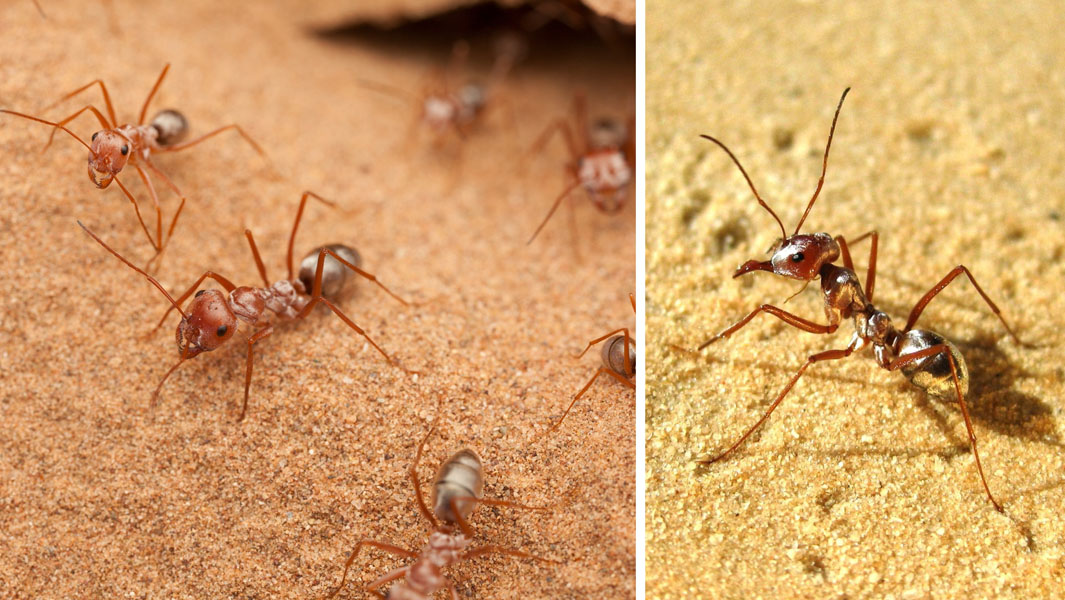World’s fastest ant gallops into record books, clocking 20 times Usain Bolt’s top speed

With lean physiques, powerful muscles and aerodynamic body shapes, certain animals just look like natural-born sprinters. But sometimes first appearances can belie a creature's true capabilities.
Such is the case with the Saharan silver ant of northern Africa. It has recently been recorded running at 855 mm per second, as reported in the Journal of Experimental Biology.
While in real terms, this might not sound like such a great distance – after all, the average man’s walking stride is 762 mm (30 in) – the significance becomes apparent when size difference is taken into account. To do that, scientists often base relative speed on body lengths per second. This fleet-footed desert-dweller can run at a staggering 108 times its own body length per second.
By comparison, the fastest land mammal over short distances, the cheetah, achieves a "meagre" 16 body lengths per second when reaching its top speed of around 100 km/h (60 mph).
And, as hard as it it is to conceive, it makes the world's fastest man, Usain Bolt (JAM), look positively sluggish; during this athlete’s unprecedented 100-m dash of 9.58 seconds in 2009, he "only" achieved 5.35 times his total height per second.

The ants are able to achieve such breakneck speeds thanks to legs that move at an exceptional velocity. Indeed, swing rates of 1,200 mm (47.2 in) per second were measured in their appendages during the research. This enables the insects to execute 47 strides per second; compare that to Usain Bolt’s four strides.
Saharan silver ants have good reason to get from A to B in the quickest time they can. In the sand-dunes where they live, surface temperatures can reach excruciating highs of 70°C (159°F). This is exacerbated by the fact that they often venture out at the hottest part of the day as they scavenge for other small animals who have succumb to the midday sun.
To keep contact with the scorching sand to a minimum, they only stay out of their underground nests for around 10 minutes. To cover as much ground as possible in that brief window, they have evolved a galloping gait which means there are brief interludes when all of their feet are in the air.

Other heat-coping features include fine, triangular-shaped silver hairs across their bodies that help to deflect the intense sun and long legs to raise their bodies off the ground. Internally, special proteins increase their tolerance to a hot climate. In fact, along with several of its cousins, this species of ant is among the most thermotolerant animals on the planet, able to withstand upper critical bodily temperatures up to 53°C (127°F) for short periods.
Ant ecologist Dr Kirsti Abbott of the School of Ants Australia, who consults for Guinness World Records on myrmecological matters, said: "That this ant species has evolved to exploit the midday heat in the Saharan Desert is testimony to the ability of ants to fill all ecological niches, both spatial and temporal.
"It’s the specifics of this strategy that are so interesting. Shorter legs, but faster strides, and a tripod gait that is almost tantamount to levitation! The speed on the ground combined with the silver hairs on its exoskeleton are just two superb adaptations that make them perfect desert dwellers.
"I think the next hare and the tortoise story must be the Cataglyphis bombycina and the hare!"
As fast as silver Saharan ants are, these ants actually come third overall in the roster of animal runners. One tiger beetle (the fastest insects on land overall) from Australia can attain 170 body lengths per second, while a tiny mite from southern California, USA, can scarper at a mind-boggling 322 body lengths per second.
Blink-and-you’ll-miss-them bugs…
Silver Saharan ants aren’t the only creepy-crawlies that have out-sped the competition and claim a record…

Fastest running insect: As mentioned in the main article, Australian tiger beetles are even faster than Saharan silver ants – both in terms of actual speed and relative speed. One species, Cicindela hudsoni, has been clocked at 2.5 m/s – that’s 9 km/h (5.6 mph). In fact, these bugs move so fast when hunting prey that they sometimes blind themselves by not allowing enough time to process visual information; they have to occasionally stop mid-chase to give their eyes a chance to “catch up” with their bodies!

Fastest flying insect: In the air, the gold medal goes to another bug that hails from Down Under: the Australian dragonfly. It has been measured reaching speeds of 58 km/h (36 mph) in short bursts, which is faster than the average galloping horse.

Fastest spider: Some mini-beasts have found ingenious ways to up their locomotive game. Take the flic-flac spider of Morocco. If it ever needs to make a quick escape, rather than running, it performs a series of flips and rolls (“flic-flac” is the name of a traditional circus tumbling act). This allows the arachnid to reach 1.7 m/s, or 6.12 km/h (3.8 mph), aided by gravity on the slopes of its sand-dune habitat.

Fastest animal appendage: Speed isn’t all about locomotion… Faster still in nature are the movements of particular body parts. The most extreme example is held by another species of ant native to the rainforests of south-east Asia and Australia. The ominously named Dracula ant can snap together its jaws at 90 m/s (324 km/h; 201 mph) – that’s around 5,000 times quicker than the blink of an eye!
From the fastest bird to the fastest invertebrate (ever heard of a sun spider?), there are lots more speedy animals to "catch up" on in Guinness World Records 2020 out now in shops and online. Hurry and get your copy today!

Thumbnail and header image: Matthias Wittlinger, Ulm University and University of Freiburg; Shutterstock


